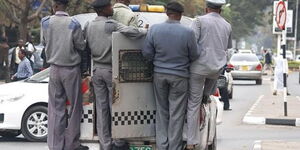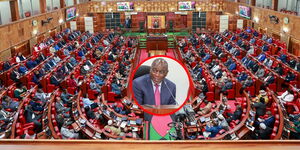Since the beginning of the pandemic, big companies whose net worth is in the billions have run broke with others even shutting down completely.
Doing business became completely hard for companies and even government agencies.
Other than running broke, Attorney General, Paul Kariuki Kihara, ordered the shut down of over 2,000 companies for failing to disclose their owners.
The data indicated that 2,540 entities were closed in 2021, more than 1,255 in 2020.
“2,540 entities were struck off the register in 2021. This was an influx. This was occasioned by enforcement of the beneficial ownership information disclosure requirements since the BOI e-register was operationalized on October 13, 2020,” the data indicated.
This means that over 6,000 firms have stopped their operations since July 2017.
Retail chain Mulleys Supermarket
The retail giant had dominated the Eastern region having stores in four counties of Nairobi, Machakos, Kitui, and Makueni. The supermarket started struggling financially forcing it to shut down half of its outlets. five out of its 10 branches were shut down.
The downsizing also saw hundreds of workers laid off as the retain chain struggled to stay afloat amid mounting debts and empty shelves.
The supermarket closed two of its main branches in Machakos town – Mulleys Express near Machakos bus station and Mulleys Pioneer situated opposite Machakos General Hospital.
Also affected were the Mulleys Kitui branch, Mulleys Highway in Mlolongo market, and Mulleys Tala branch.
The supermarket started showing signs of running broke six months ago, which was revealed by the empty shelves in their retail stores.
Kenya Power and Lighting Company
KPLC was among the multi-billion companies in the country that had huge income flow at the end of every financial year. However, the proceeds started dwindling as services deteriorated.
In a report that was released by Auditor General, Nancy Gathungu, on November 12, Kenya power was declared broke. The report indicated Kenya Power’s liabilities stood at Ksh116.11 billion against the Ksh49.63 billion assets. That brought about a difference of Ksh66.47 billion, showing it was incapable of undertaking its financial obligations.
Gathungu advised Kenya Power and Lighting Company (KPLC) to seek additional funding for capital expenditure to expand, improve and maintain its network, which could decline into more debt.
The report compelled the national government to call for a complete overhaul of the sector that saw top bosses lose their jobs to pave way for reforms aimed at returning to profitability.
Imperial Bank Limited
In a statement dated Thursday, December 9, The Central Bank of Kenya (CBK) announced the shutting down of Imperial Bank Limited.
The decision was arrived at after the Kenya Deposit Insurance Corporation (KDIC) submitted a receivership report to CBK recommending for the liquidation of the financial institution.
The troubled bank started showing signs of running broke in October 2015, when it was placed under receivership and the Kenya Deposit Insurance Corporation (KDIC) appointed as the receiver.
During this period, several attempts were made to return the bank to its winning ways but the efforts failed. In September 2020, CBK asked for the appointment of an external auditor to examine Imperial Bank’s books.
The audit report, which was submitted to KDIC on December 7, 2021, recommended that the bank be placed in liquidation, as it had become insolvent and that was the end of its existence in the country.
Nzoia Sugar
Nzoia Sugar company was hit by a stream of uncertainties showing signs of it shutting down its operations. The situation went viral after photos of trucks delivering sugarcane to the company appeared stranded, igniting public debate.
It emerged that the multi-million sugar milling firm owes farmers Ksh743 million, while transporters are owed Ksh182.4 million and cane harvesters demanding Ksh71.3 million.
Nzoia Sugar owed Nzoia Out Growers Company (NOCO) Ksh4.8 million. Unpaid cess to the county government stood at Ksh10.1 million.
The company became completely broke but President Uhuru Kenyatta intervened. Agriculture Cabinet Secretary, Peter Munya, on November 8, handed over a cheque of Ksh500 million in efforts to revive the miller.
“The money will kick-start operations of the miller and boost the morale of the employees and farmers,” Munya stated.
The bail out saved the company that was completely broke having paid workers in April 2020 accumulating salary debt of close to a year.
Moi University
The Auditor General, in her report, declared Moi University technically insolvent. She stated debts exceeded Ksh4.5 billion and the institution could not service its own operations.
The auditor noted that in 2018-19, the consolidated statement of its financial position reflected total liabilities of Ksh4.5 billion and assets of Ksh4 billion.
“This resulted in a negative working capital of Ksh407.3 million as of June 30, 2019," the report read in part.
It added, "In the circumstances, the ongoing concern of the university in the absence of continued support from the government and creditors is in doubt."
This prompted EACC to start probing into allegations of embezzlement of funds and bloated workforce.
University of Nairobi
The University of Nairobi was rocked with a series of crises including; costly court cases, a gaping budget deficit, student unrest, falling student numbers, labour tiffs and controversial restructuring of its top echelons. The institution found itself in the most challenging situation.
On July 11, UoN announced that it had more than doubled fees for postgraduate courses and parallel degrees to ease a financial crunch.
The rise in fees triggered a floodgate of questions for the country's largest institution of higher learning. The issue of it wallowing in debts became exposed.
The Treasury revealed to Parliament on November 7 that UoN had a deficit of Ksh2.17 billion in the year to June, up from Ksh1.62 billion in 2020.
Kenyatta University was also exposed with its deficit dipping to Ksh2.13 billion in the period under review from Ksh1.3 billion with the institution relying on short-term loans to finance its operations.
In recent months, a number of universities have had to scrap some courses and close satellite campuses to cut the cost of operations. From making millions in full financial years to making losses accounting to billions became the new reality for the institutions, painting a clear picture of what the country's economy is at the moment.
But with all the financial constraints and huge losses, the Uhuru-led government is mulling plans to return all the multi-billion businesses to their full potential before he exits power in August 2022.












